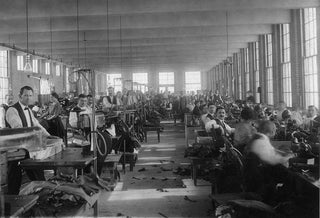Written by Sara Rising
Rochester has a long history of innovation and is home to some of the largest, most influential giants of industry. Take, for example, Kodak, Xerox, Bausch & Lomb, Ragu and Wegmans. These names are synonymous with Rochester, but what about the city’s lesser-known giants? Before we were known as the Flour City or the birthplace of film, Rochester was a huge hub for the garment industry. The garment district, located in the St. Paul neighborhood, is still home to one of the oldest clothiers in the country, Hickey Freeman.

St. Paul Quarter
Jehiel Barnard was Rochester’s first tailor, setting up shop in what is now Reynolds Arcade. He arrived in 1812, the same year as the city’s permanent settlement. By 1834, at least 20 tailors were operating in Rochester. By 1848, Rochester was home to more than 30 garment shops. Most of these were crowded in low wooden structures along the Main Street Bridge and nearby Front Street. Tailor shops soon made way for wholesale manufacturing, most of which were headquartered on Mill Street. In 1879, some 2,700 workers filled the factories daily. In the 1890’s, Rochester was the 4th largest manufacturer of men’s clothing in America. By the end of the Great Depression, the industry was mostly controlled by a handful of powerful companies: Michael-Sterns, Timely Clothes, Fashion Park, Bonds Clothes and Hickey Freeman.

Inside the Hickey-Freeman Factory, Rochester
(photo courtesy of Hickey Freeman)
Today, only Hickey Freeman remains. Talented craftsmen are still making suits in the same 77,000 square foot factory on North Clinton Avenue that they did way back in 1899, when the company was first founded. If you take a peek at the Heritage section on the Hickey Freeman website, you will find some great shots of what the factory looked like in its heyday.
Fast forward to 2016 and you will find very different neighborhood. Those incredible industrial buildings on St. Paul, North Water and Andrews Streets have recently been converted to loft apartments, artist studios, professional offices and trendy restaurants. It is also home to Waterstreet Music Hall, where high-school me saw some pretty great shows in the early 2000’s.

Rochester Button Company factory (left) circa 1930’s
(photo courtesy of Rochester City Photo lab and the Democrat & Chronicle)
For those interested in delving deeper into the history of Rochester’s clothiers, check out ‘Tailor Made: The Story of Rochester’s Garment Industry,’ which premiers Monday, February 29 at 8 p.m. on WXXI-TV.
Sources:
“The Men’s Clothing Industry in Rochester’s History,” by Blake McKelvey, City Historian, July, 1960.
“Retrofitting Rochester: Rochester Button Company,” by Jeff Ludwig, Historical Researcher, City of Rochester, Democrat & Chronical in partnership with the Office of the City Historian.
Tailor Made: The Story of Rochester’s Garment Industry, Media Release, WXXI.
